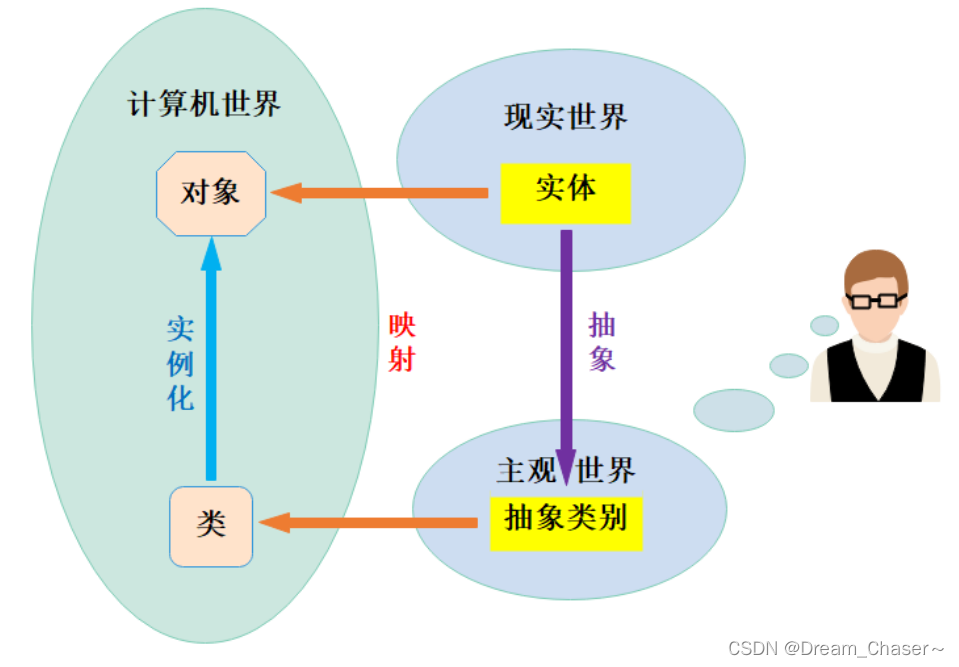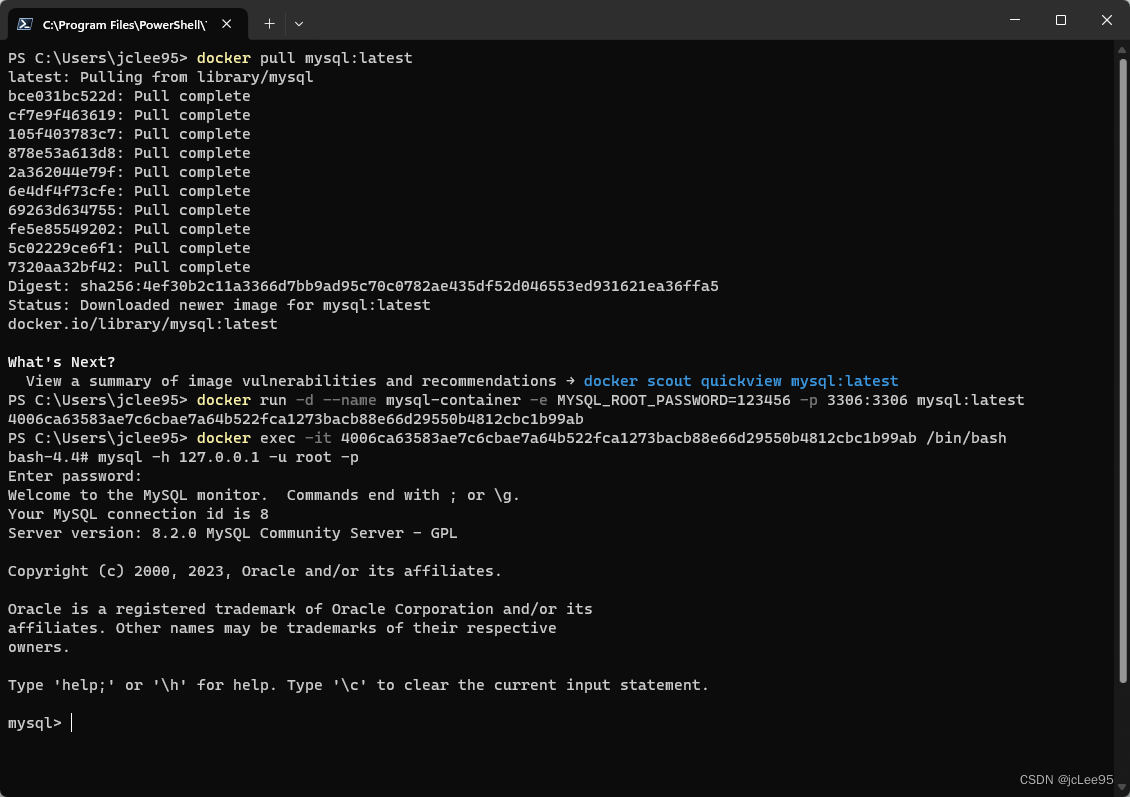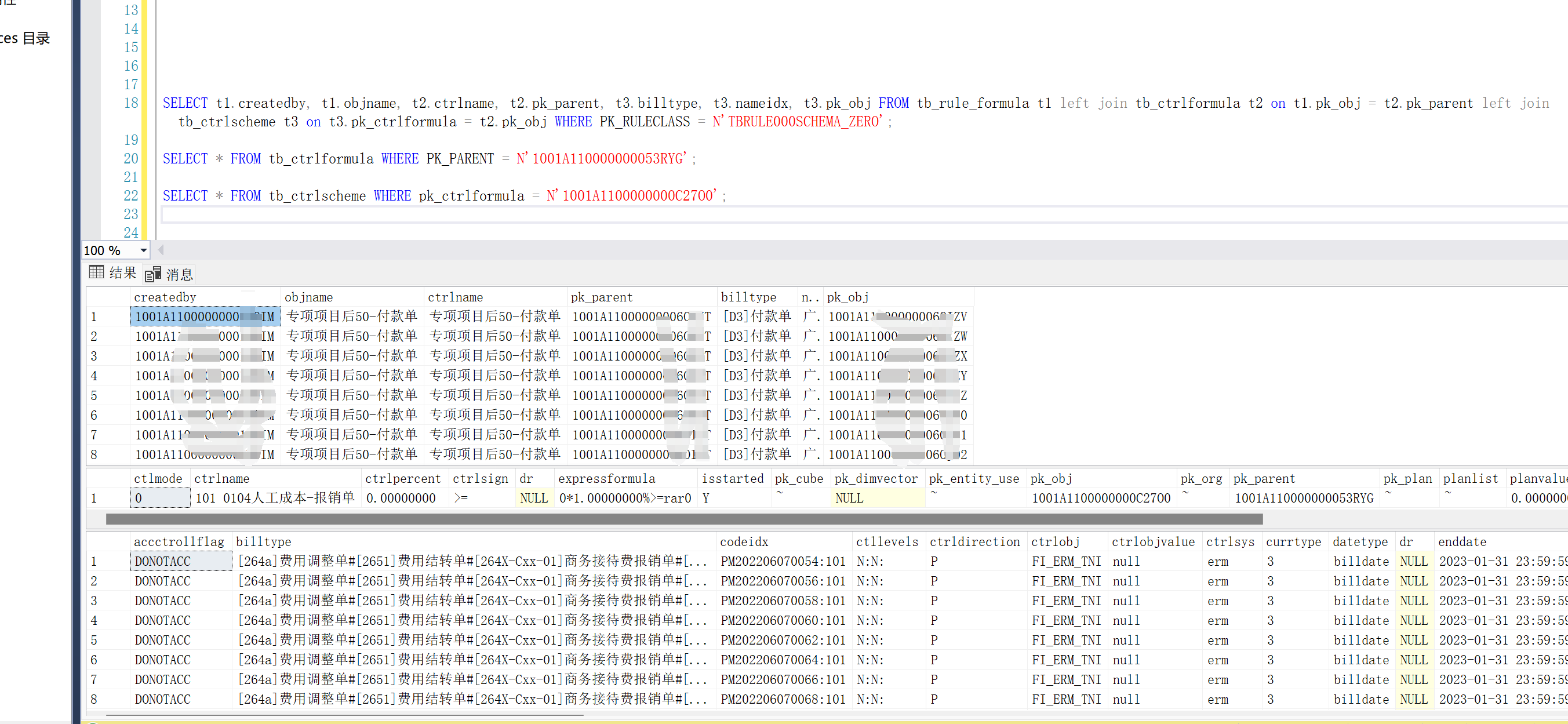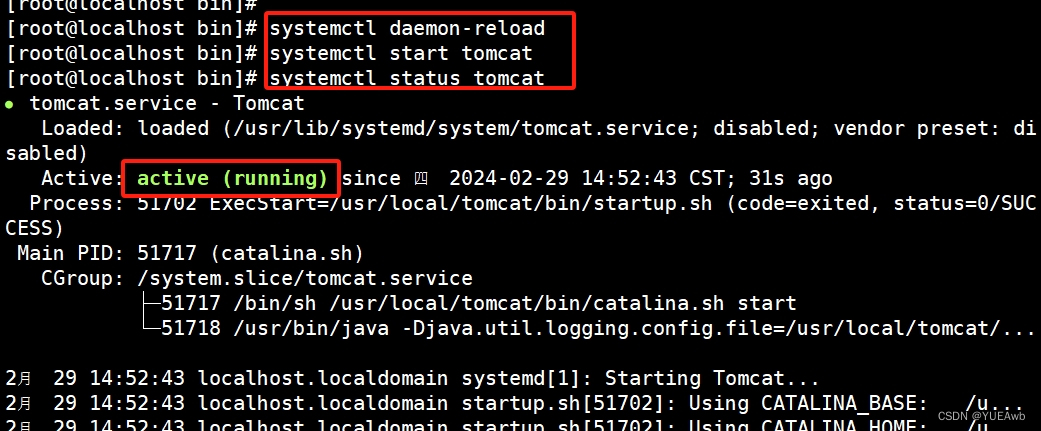上篇文章 《使用mininet快速入门ONOS路由交换技术与原理-交换篇》
使用mininet搭建了一个简单的网络拓扑,并实现了同一交换机下同网段多主机的通信,其中涉及到的通信知识主要以二层mac地址通信为主。
但在芸芸网络的世界中,主机间的通信除了二层域外更多的还是纷繁复杂的三层ip路由通信。
路由协议可分为静态路由协议和动态路由协议,在动态路由协议中,根据路由协议的作用范围主要又分为IGP与EGP。

其中EGP中的BGP协议根据其强悍的设计可支撑起各数以亿记的路由条目,同是也是动态路由协议中最为复杂的一个。
本文将结合BGP路由协议,通过onos官方的一个sdnip小示例实现SDN下不同网段多主机的通信。
环境说明
linux系统主机一台(可虚拟机,笔者使用的是ubuntu)
拓扑如下:
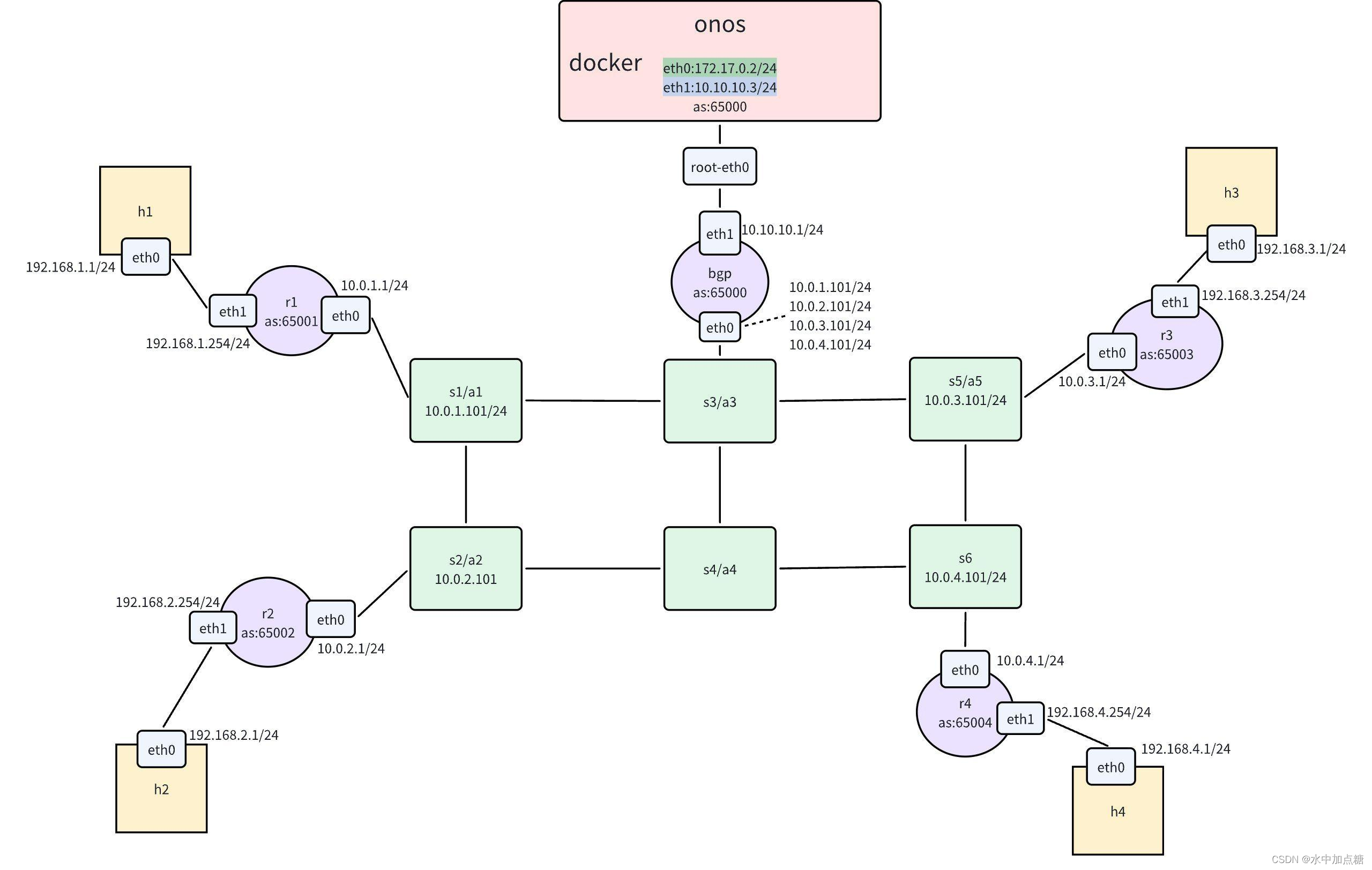
拓扑说明
- 一个onos
- 6个ovs交换机
- 其中5台交换机各自连一个路由器,且其4台路由器上各自连接一个主机,另一台路由器与onos连通
- 4个主机处于不同的网段
quagga安装与操作
quagga介绍
由于后续需要模拟外部路由器,这里使用quagga进行模拟。
qugga是一个实现了常用路由协议的软件套件,在进行网络设备模拟时非常有用,其官网地址为:https://www.nongnu.org/quagga

同时它也是一个开源软件,源码源码地址为:https://github.com/Quagga/quagga
quagga安装
选择一个系统对应的安装方式进行安装,如ubuntu执行下命令直接安装即可:
sudo apt install bridge-utils
#quagga 1.2.4
sudo apt-get install quagga
可选项:
sudo cp /usr/share/doc/quagga-core/examples/zebra.conf.sample /etc/quagga/zebra.conf
sudo cp /usr/share/doc/quagga-core/examples/ospfd.conf.sample /etc/quagga/ospfd.conf
sudo cp /usr/share/doc/quagga-core/examples/zebra.conf.sample /etc/quagga/r1zebra.conf
sudo cp /usr/share/doc/quagga-core/examples/zebra.conf.sample /etc/quagga/r2zebra.conf
sudo cp /usr/share/doc/quagga-core/examples/ospfd.conf.sample /etc/quagga/r1ospfd.conf
sudo cp /usr/share/doc/quagga-core/examples/ospfd.conf.sample /etc/quagga/r2ospfd.conf
可选项:
sudo cp /usr/lib/quagga/* /lib
quagga操作
quagga提供了丰富的配置选项以支持对模拟的路由器进行相应的配置,对应的操作手册地址为:
https://www.nongnu.org/quagga/docs/quagga.html
如要查看bgp路由列表,在进入控制台后输入以下命令查看即可
telnet localhost 2605
show ip bgp
另,为了后续在mininet中可正确使用xterm命令,需要确保已安装xterm工具
sudo apt install xterm
拓扑创建
quagga仿真软件安装就绪后,接下来便可以对整个拓扑创建就可以了。
onos仍然使用docker运行,其余交换机、路由器、主机的创建创建使用自定义的mininet脚本进行创建。
onos与网桥创建
#启动onos,并映射端口(验证:访问8181web界面)
docker run -d -e TZ=Asia/Shanghai -p 6653:6653 -p 8101:8101 -p 8181:8181 --name onos onosproject/onos:2.7.0
创建docker网桥,并指定10.10.10网段
docker network create --subnet 10.10.10.0/24 --ip-range 10.10.10.0/24 --gateway 10.10.10.2 sdnip
让onos容器与docker网桥连接,并分配10.10.10.3地址(验证:主机ping通10.10.10.3)
docker network connect --ip 10.10.10.3 sdnip onos
启动openflow应用
app activate org.onosproject.openflow
定义拓扑脚本
#!/usr/bin/python3
from mininet.cli import CLI
from mininet.log import setLogLevel, info, debug
from mininet.net import Mininet
from mininet.node import Host, RemoteController
from mininet.topo import Topo
QUAGGA_DIR = '/usr/lib/quagga'
# Must exist and be owned by quagga user (quagga:quagga by default on Ubuntu)
# QUAGGA_RUN_DIR = '/var/run/quagga'
QUAGGA_RUN_DIR = '/tmp'
CONFIG_DIR = 'configs'
class SdnIpHost(Host):
def __init__(self, name, ip, route, *args, **kwargs):
Host.__init__(self, name, ip=ip, *args, **kwargs)
self.route = route
def config(self, **kwargs):
Host.config(self, **kwargs)
debug("configuring route %s" % self.route)
self.cmd('ip route add default via %s' % self.route)
class Router(Host):
def __init__(self, name, quaggaConfFile, zebraConfFile, intfDict, *args, **kwargs):
Host.__init__(self, name, *args, **kwargs)
self.quaggaConfFile = quaggaConfFile
self.zebraConfFile = zebraConfFile
self.intfDict = intfDict
def config(self, **kwargs):
Host.config(self, **kwargs)
self.cmd('sysctl net.ipv4.ip_forward=1')
for intf, attrs in self.intfDict.items():
self.cmd('ip addr flush dev %s' % intf)
if 'mac' in attrs:
self.cmd('ip link set %s down' % intf)
self.cmd('ip link set %s address %s' % (intf, attrs['mac']))
self.cmd('ip link set %s up ' % intf)
for addr in attrs['ipAddrs']:
self.cmd('ip addr add %s dev %s' % (addr, intf))
# self.cmd('/usr/lib/quagga/zebra -d -f %s -z %s/zebra%s.api -i %s/zebra%s.pid' % (
self.cmd('zebra -d -f %s -z %s/zebra%s.api -i %s/zebra%s.pid' % (
self.zebraConfFile, QUAGGA_RUN_DIR, self.name, QUAGGA_RUN_DIR, self.name))
# self.cmd('/usr/lib/quagga/bgpd -d -f %s -z %s/zebra%s.api -i %s/bgpd%s.pid' % (
self.cmd('bgpd -d -f %s -z %s/zebra%s.api -i %s/bgpd%s.pid' % (
self.quaggaConfFile, QUAGGA_RUN_DIR, self.name, QUAGGA_RUN_DIR, self.name))
def terminate(self):
self.cmd("ps ax | egrep 'bgpd%s.pid|zebra%s.pid' | awk '{print $1}' | xargs kill" % (self.name, self.name))
Host.terminate(self)
class SdnIpTopo(Topo):
"SDN-IP tutorial topology"
def build(self):
s1 = self.addSwitch('s1', dpid='00000000000000a1')
s2 = self.addSwitch('s2', dpid='00000000000000a2')
s3 = self.addSwitch('s3', dpid='00000000000000a3')
s4 = self.addSwitch('s4', dpid='00000000000000a4')
s5 = self.addSwitch('s5', dpid='00000000000000a5')
s6 = self.addSwitch('s6', dpid='00000000000000a6')
zebraConf = '%s/zebra.conf' % CONFIG_DIR
# Switches we want to attach our routers to, in the correct order
attachmentSwitches = [s1, s2, s5, s6]
for i in range(1, 4 + 1):
name = 'r%s' % i
eth0 = {'mac': '00:00:00:00:0%s:01' % i,
'ipAddrs': ['10.0.%s.1/24' % i]}
eth1 = {'ipAddrs': ['192.168.%s.254/24' % i]}
intfs = {'%s-eth0' % name: eth0,
'%s-eth1' % name: eth1}
quaggaConf = '%s/quagga%s.conf' % (CONFIG_DIR, i)
router = self.addHost(name, cls=Router, quaggaConfFile=quaggaConf,
zebraConfFile=zebraConf, intfDict=intfs)
host = self.addHost('h%s' % i, cls=SdnIpHost,
ip='192.168.%s.1/24' % i,
route='192.168.%s.254' % i)
self.addLink(router, attachmentSwitches[i - 1])
self.addLink(router, host)
# Set up the internal BGP speaker
bgpEth0 = {'mac': '00:00:00:00:00:01',
'ipAddrs': ['10.0.1.101/24',
'10.0.2.101/24',
'10.0.3.101/24',
'10.0.4.101/24', ]}
bgpEth1 = {'ipAddrs': ['10.10.10.1/24']}
bgpIntfs = {'bgp-eth0': bgpEth0,
'bgp-eth1': bgpEth1}
bgp = self.addHost("bgp", cls=Router,
quaggaConfFile='%s/quagga-sdn.conf' % CONFIG_DIR,
zebraConfFile=zebraConf,
intfDict=bgpIntfs)
self.addLink(bgp, s3)
# Connect BGP speaker to the root namespace so it can peer with ONOS
root = self.addHost('root', inNamespace=False, ip='10.10.10.2/24')
self.addLink(root, bgp)
# Wire up the switches in the topology
self.addLink(s1, s2)
self.addLink(s1, s3)
self.addLink(s2, s4)
self.addLink(s3, s4)
self.addLink(s3, s5)
self.addLink(s4, s6)
self.addLink(s5, s6)
topos = {'sdnip': SdnIpTopo}
if __name__ == '__main__':
setLogLevel('debug')
topo = SdnIpTopo()
net = Mininet(topo=topo, controller=RemoteController)
net.start()
CLI(net)
net.stop()
info("done\n")
定义一个python3的拓扑,名为tutorial-py3.py。其中定义了所需要的交换机、主机、路由器的link关系。
bgp路由器配置文件
如上面拓扑定义python脚本所示,各bgp路由器还需要读取对应的quagga配置文件,其中描述的对应bgp路由器的bgp配置信息。
quagga1.conf
! BGP configuration for r1
!
hostname r1
password sdnip
!
router bgp 65001
bgp router-id 10.0.1.1
timers bgp 3 9
neighbor 10.0.1.101 remote-as 65000
neighbor 10.0.1.101 ebgp-multihop
neighbor 10.0.1.101 timers connect 5
neighbor 10.0.1.101 advertisement-interval 5
network 192.168.1.0/24
!
log stdout
quagga2.conf
! BGP configuration for r2
!
hostname r2
password sdnip
!
router bgp 65002
bgp router-id 10.0.2.1
timers bgp 3 9
neighbor 10.0.2.101 remote-as 65000
neighbor 10.0.2.101 ebgp-multihop
neighbor 10.0.2.101 timers connect 5
neighbor 10.0.2.101 advertisement-interval 5
network 192.168.2.0/24
!
log stdout
quagga3.conf
! BGP configuration for r3
!
hostname r3
password sdnip
!
router bgp 65003
bgp router-id 10.0.3.1
timers bgp 3 9
neighbor 10.0.3.101 remote-as 65000
neighbor 10.0.3.101 ebgp-multihop
neighbor 10.0.3.101 timers connect 5
neighbor 10.0.3.101 advertisement-interval 5
network 192.168.3.0/24
!
log stdout
quagga4.conf
! BGP configuration for r4
!
hostname r4
password sdnip
!
router bgp 65004
bgp router-id 10.0.4.1
timers bgp 3 9
neighbor 10.0.4.101 remote-as 65000
neighbor 10.0.4.101 ebgp-multihop
neighbor 10.0.4.101 timers connect 5
neighbor 10.0.4.101 advertisement-interval 5
!network 192.168.4.0/24
!
log stdout
注意,这里的quagga4.conf中并未并192.168.4.0/24网段进行公告
quagga-sdn.conf
!
hostname bgp
password sdnip
!
!
router bgp 65000
bgp router-id 10.10.10.1
timers bgp 3 9
!
neighbor 10.0.1.1 remote-as 65001
neighbor 10.0.1.1 ebgp-multihop
neighbor 10.0.1.1 timers connect 5
neighbor 10.0.1.1 advertisement-interval 5
!
neighbor 10.0.2.1 remote-as 65002
neighbor 10.0.2.1 ebgp-multihop
neighbor 10.0.2.1 timers connect 5
neighbor 10.0.2.1 advertisement-interval 5
!
neighbor 10.0.3.1 remote-as 65003
neighbor 10.0.3.1 ebgp-multihop
neighbor 10.0.3.1 timers connect 5
neighbor 10.0.3.1 advertisement-interval 5
!
neighbor 10.0.4.1 remote-as 65004
neighbor 10.0.4.1 ebgp-multihop
neighbor 10.0.4.1 timers connect 5
neighbor 10.0.4.1 advertisement-interval 5
!
! ONOS
neighbor 10.10.10.3 remote-as 65000
neighbor 10.10.10.3 port 2000
neighbor 10.10.10.3 timers connect 5
!
log stdout
quagga-sdn.conf为bgp反射器那个路由器的配置,与r1-r4属于ebgp关系,与onos属于ibgp关系。
mininet模拟交换机、路由器、主机
拓扑描述脚本与quagga配置文件准备好后便可启动拓扑了
#启动mininet,连接指定控制器(验证:onos中查看设备是否上线)
sudo mn --custom tutorial-py3.py --topo sdnip --controller remote,172.17.0.2 --nolistenport
拓扑中的设备创建好后,为了能让ibgp通信正常,还需要让bgp-router与onos连通。
找到docker容器10.10.10.3对应的网桥,将root-eth0加入到其中
brctl show
#sdnip网桥中添加root-eth0(验证:bgp与onos能ping通)
sudo brctl addif br-baab72ffcdfc root-eth0
测试连通性,此时是不通的
h1 ping h2
sdn-ip应用与配置
前面的步骤仅完成了拓扑的搭建,拓扑中的节点间还是处于无法通信的状态。
如想要拓扑中的各节点进行正常通信,需要onos下发流表到交换机指导数据包的转发。
此刻sdn-ip的作用便可以发挥出来了,在sdn-ip应用中实现了bgp的协议与路由储存的基本功能,并能通过所学到的route下发对应的intent,最后下发flowRule到交换机中。细节部分此处不详细展开。
sdnip应用启动
#onos集群下需要先启动confgi
app activate org.onosproject.config
#启动sdnip应用
app activate org.onosproject.sdnip
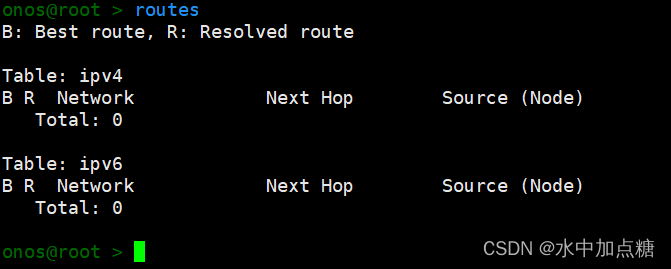
待sdnip应用启动后便可以使用routes命令,此时onos中的route列表仍然是空的
sdnIp应用配置
访问onos的http接口,找到network配置项注入配置信息。如访问地址为:
http://172.17.0.2:8181/onos/v1/docs/#!/network47configuration/post_network_configuration
也可使用curl进行更新,如:
curl --user onos:rocks -X POST -H “Content-Type: application/json” http://172.17.0.2:8181/onos/v1/network/configuration/ -d @/home/sdn/sdnip/configs/network-cfg.json
其中传入的配置信息内容如下:
{
"ports" : {
"of:00000000000000a1/1" : {
"interfaces" : [
{
"name" : "sw1-1",
"ips" : [ "10.0.1.101/24" ],
"mac" : "00:00:00:00:00:01"
}
]
},
"of:00000000000000a2/1" : {
"interfaces" : [
{
"name" : "sw2-1",
"ips" : [ "10.0.2.101/24" ],
"mac" : "00:00:00:00:00:01"
}
]
},
"of:00000000000000a5/1" : {
"interfaces" : [
{
"name" : "sw5-1",
"ips" : [ "10.0.3.101/24" ],
"mac" : "00:00:00:00:00:01"
}
]
},
"of:00000000000000a6/1" : {
"interfaces" : [
{
"name" : "sw6-1",
"ips" : [ "10.0.4.101/24" ],
"mac" : "00:00:00:00:00:01"
}
]
}
},
"apps" : {
"org.onosproject.router" : {
"bgp" : {
"bgpSpeakers" : [
{
"name" : "speaker1",
"connectPoint" : "of:00000000000000a3/1",
"peers" : [
"10.0.1.1",
"10.0.2.1",
"10.0.3.1",
"10.0.4.1"
]
}
]
}
}
}
}
配置成功后使用interfaces和bgp-speakers命令验证一下

连通验证
当sdn-ip应用启动成功后,并且配置了对应的信息后,sdn-ip会执行一系列的操作最终会下发所学到的路由记录到交换机中

此时再查看routes信息,发现也学到了路由记录
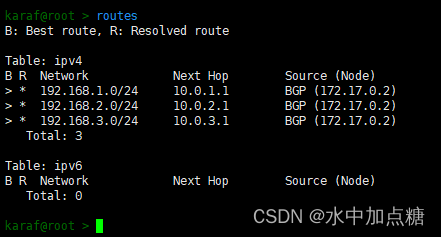
查看flows信息也可看到由intent所下发的流表项,片段如下:
deviceId=of:00000000000000a1, flowRuleCount=17
ADDED, bytes=65330, packets=470, table=0, priority=40000, selector=[ETH_TYPE:lldp], treatment=[immediate=[OUTPUT:CONTROLLER], clearDeferred]
ADDED, bytes=65330, packets=470, table=0, priority=40000, selector=[ETH_TYPE:bddp], treatment=[immediate=[OUTPUT:CONTROLLER], clearDeferred]
ADDED, bytes=84, packets=2, table=0, priority=40000, selector=[ETH_TYPE:arp], treatment=[immediate=[OUTPUT:CONTROLLER], clearDeferred]
ADDED, bytes=29699, packets=378, table=0, priority=1000, selector=[IN_PORT:1, ETH_TYPE:ipv4, IP_PROTO:6, IPV4_SRC:10.0.1.1/32, IPV4_DST:10.0.1.101/32, TCP_DST:179], treatment=[immediate=[OUTPUT:3]]
ADDED, bytes=0, packets=0, table=0, priority=1000, selector=[IN_PORT:1, ETH_TYPE:ipv4, IP_PROTO:1, IPV4_SRC:10.0.1.1/32, IPV4_DST:10.0.1.101/32], treatment=[immediate=[OUTPUT:3]]
ADDED, bytes=0, packets=0, table=0, priority=1000, selector=[IN_PORT:2, ETH_TYPE:ipv4, IP_PROTO:6, IPV4_SRC:10.0.2.1/32, IPV4_DST:10.0.2.101/32, TCP_SRC:179], treatment=[immediate=[OUTPUT:3]]
ADDED, bytes=0, packets=0, table=0, priority=1000, selector=[IN_PORT:1, ETH_TYPE:ipv4, IP_PROTO:6, IPV4_SRC:10.0.1.1/32, IPV4_DST:10.0.1.101/32, TCP_SRC:179], treatment=[immediate=[OUTPUT:3]]
ADDED, bytes=36604, packets=482, table=0, priority=1000, selector=[IN_PORT:3, ETH_TYPE:ipv4, IP_PROTO:6, IPV4_SRC:10.0.1.101/32, IPV4_DST:10.0.1.1/32, TCP_SRC:179], treatment=[immediate=[OUTPUT:1]]
ADDED, bytes=0, packets=0, table=0, priority=1000, selector=[IN_PORT:2, ETH_TYPE:ipv4, IP_PROTO:1, IPV4_SRC:10.0.2.1/32, IPV4_DST:10.0.2.101/32], treatment=[immediate=[OUTPUT:3]]
ADDED, bytes=33197, packets=431, table=0, priority=1000, selector=[IN_PORT:2, ETH_TYPE:ipv4, IP_PROTO:6, IPV4_SRC:10.0.2.1/32, IPV4_DST:10.0.2.101/32, TCP_DST:179], treatment=[immediate=[OUTPUT:3]]
ADDED, bytes=0, packets=0, table=0, priority=1000, selector=[IN_PORT:3, ETH_TYPE:ipv4, IP_PROTO:6, IPV4_SRC:10.0.1.101/32, IPV4_DST:10.0.1.1/32, TCP_DST:179], treatment=[immediate=[OUTPUT:1]]
ADDED, bytes=0, packets=0, table=0, priority=1000, selector=[IN_PORT:3, ETH_TYPE:ipv4, IP_PROTO:1, IPV4_SRC:10.0.1.101/32, IPV4_DST:10.0.1.1/32], treatment=[immediate=[OUTPUT:1]]
ADDED, bytes=98, packets=1, table=0, priority=220, selector=[IN_PORT:1, ETH_TYPE:ipv4, IPV4_DST:192.168.3.0/24], treatment=[immediate=[ETH_DST:00:00:00:00:03:01, OUTPUT:3]]
ADDED, bytes=98, packets=1, table=0, priority=220, selector=[IN_PORT:3, ETH_DST:00:00:00:00:01:01], treatment=[immediate=[OUTPUT:1]]
ADDED, bytes=196, packets=2, table=0, priority=220, selector=[IN_PORT:2, ETH_DST:00:00:00:00:01:01], treatment=[immediate=[OUTPUT:1]]
ADDED, bytes=196, packets=2, table=0, priority=220, selector=[IN_PORT:1, ETH_TYPE:ipv4, IPV4_DST:192.168.2.0/24], treatment=[immediate=[ETH_DST:00:00:00:00:02:01, OUTPUT:2]]
ADDED, bytes=0, packets=0, table=0, priority=220, selector=[IN_PORT:3, ETH_DST:00:00:00:00:02:01], treatment=[immediate=[OUTPUT:2]]
deviceId=of:00000000000000a2, flowRuleCount=14
ADDED, bytes=65052, packets=468, table=0, priority=40000, selector=[ETH_TYPE:bddp], treatment=[immediate=[OUTPUT:CONTROLLER], clearDeferred]
ADDED, bytes=84, packets=2, table=0, priority=40000, selector=[ETH_TYPE:arp], treatment=[immediate=[OUTPUT:CONTROLLER], clearDeferred]
ADDED, bytes=65052, packets=468, table=0, priority=40000, selector=[ETH_TYPE:lldp], treatment=[immediate=[OUTPUT:CONTROLLER], clearDeferred]
ADDED, bytes=33197, packets=431, table=0, priority=1000, selector=[IN_PORT:1, ETH_TYPE:ipv4, IP_PROTO:6, IPV4_SRC:10.0.2.1/32, IPV4_DST:10.0.2.101/32, TCP_DST:179], treatment=[immediate=[OUTPUT:2]]
ADDED, bytes=0, packets=0, table=0, priority=1000, selector=[IN_PORT:1, ETH_TYPE:ipv4, IP_PROTO:6, IPV4_SRC:10.0.2.1/32, IPV4_DST:10.0.2.101/32, TCP_SRC:179], treatment=[immediate=[OUTPUT:2]]
ADDED, bytes=0, packets=0, table=0, priority=1000, selector=[IN_PORT:3, ETH_TYPE:ipv4, IP_PROTO:6, IPV4_SRC:10.0.2.101/32, IPV4_DST:10.0.2.1/32, TCP_DST:179], treatment=[immediate=[OUTPUT:1]]
ADDED, bytes=0, packets=0, table=0, priority=1000, selector=[IN_PORT:1, ETH_TYPE:ipv4, IP_PROTO:1, IPV4_SRC:10.0.2.1/32, IPV4_DST:10.0.2.101/32], treatment=[immediate=[OUTPUT:2]]
ADDED, bytes=34822, packets=455, table=0, priority=1000, selector=[IN_PORT:3, ETH_TYPE:ipv4, IP_PROTO:6, IPV4_SRC:10.0.2.101/32, IPV4_DST:10.0.2.1/32, TCP_SRC:179], treatment=[immediate=[OUTPUT:1]]
ADDED, bytes=0, packets=0, table=0, priority=1000, selector=[IN_PORT:3, ETH_TYPE:ipv4, IP_PROTO:1, IPV4_SRC:10.0.2.101/32, IPV4_DST:10.0.2.1/32], treatment=[immediate=[OUTPUT:1]]
ADDED, bytes=0, packets=0, table=0, priority=220, selector=[IN_PORT:3, ETH_DST:00:00:00:00:02:01], treatment=[immediate=[OUTPUT:1]]
ADDED, bytes=196, packets=2, table=0, priority=220, selector=[IN_PORT:1, ETH_TYPE:ipv4, IPV4_DST:192.168.1.0/24], treatment=[immediate=[ETH_DST:00:00:00:00:01:01, OUTPUT:2]]
ADDED, bytes=196, packets=2, table=0, priority=220, selector=[IN_PORT:2, ETH_DST:00:00:00:00:02:01], treatment=[immediate=[OUTPUT:1]]
ADDED, bytes=0, packets=0, table=0, priority=220, selector=[IN_PORT:3, ETH_DST:00:00:00:00:01:01], treatment=[immediate=[OUTPUT:2]]
ADDED, bytes=0, packets=0, table=0, priority=220, selector=[IN_PORT:1, ETH_TYPE:ipv4, IPV4_DST:192.168.3.0/24], treatment=[immediate=[ETH_DST:00:00:00:00:03:01, OUTPUT:3]]
……
此时再在mininet中进行h1 ping h2便会发现可以ping通了,且ttl值也作了对应的减少
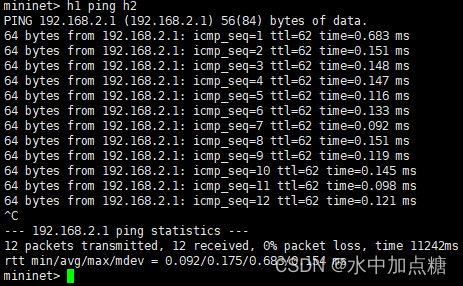
通信过程原理
sdnip可以让以上拓扑通信成功的过程内容稍微有点多,这里从onos官网中拷贝出几张有价值的图例可参考一下:
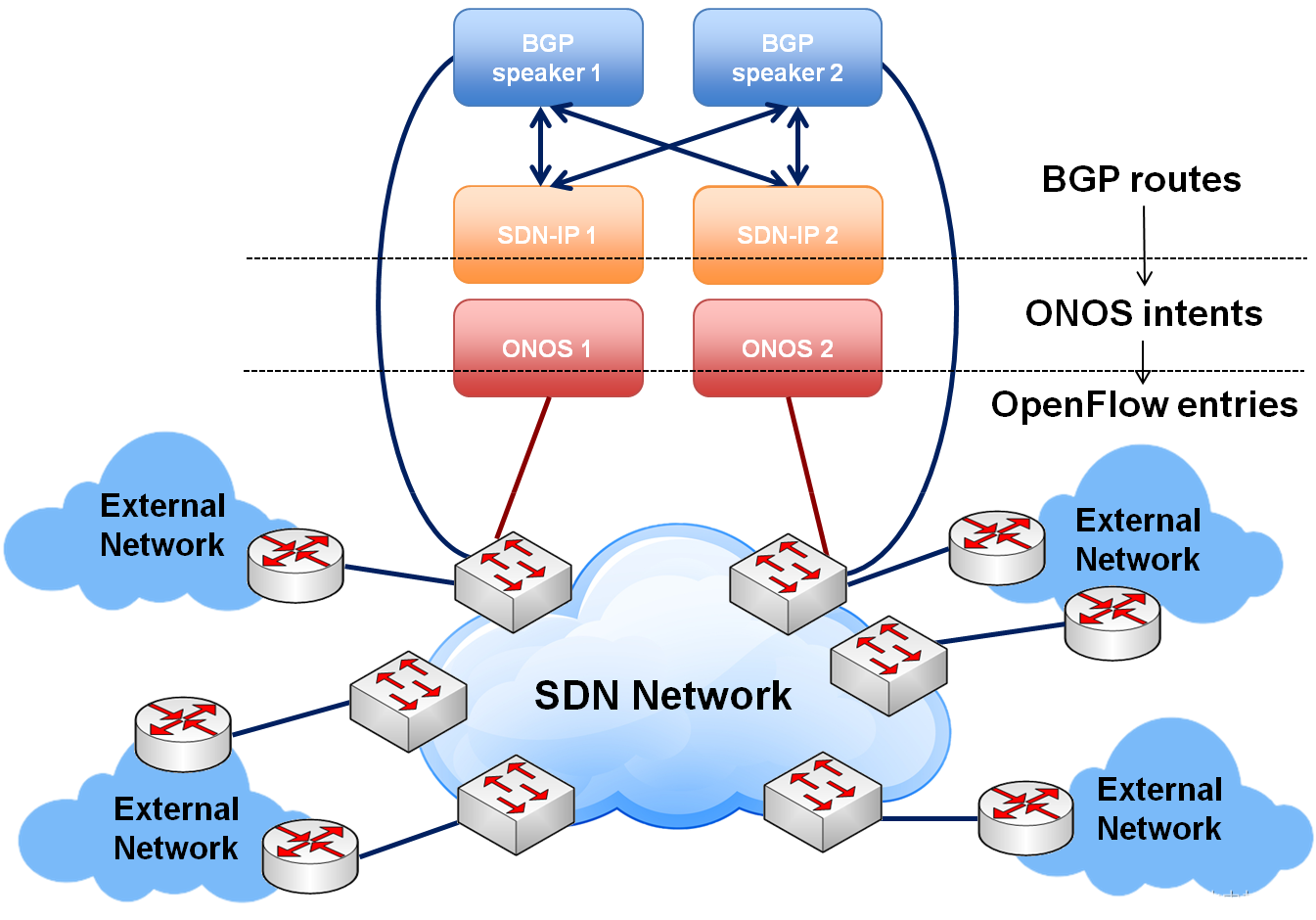
上图描述了BGP路由记录由routes转为intents,再由intents转为flowRule流表项的大体流程
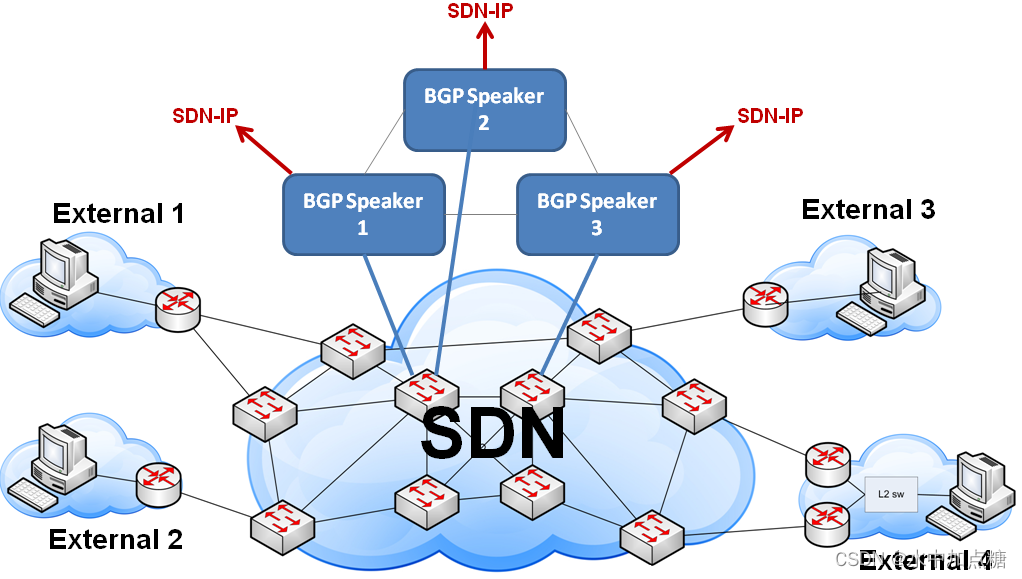
上图描述了在BGP网络中,路由传递到SDN-IP的大体过程,主要为由EBGP进行路由汇总。
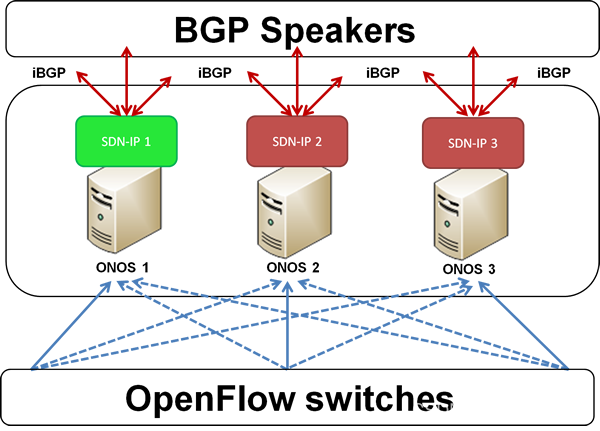
以上图描述了在由BGP反射器学到了EBGP的路由后,再由IBGP传递给onos应用sdn-ip的过程。
再总结一下:
通信成功的原理可以参考onos官方wiki中sdnip应用的架构描述部分,主要为在onos配置了bgp信息和interface后下发了
Single-point to single-point intents,实现了bgp各节点的通信;随后在onos学到了bgp路由信息后向交换机下发了
Multi-point to single-point intents,实现了各主机间的通信。
新增ebgp节点路由公告
上面实现了h1、h2、h3这3个主机间的互相通信,但h4还没有通,这是因为在r4路由器的bgp配置中未将192.168.4.0/24网段公告出去,也就导致onos不能通过ibgp学到r4路由器的主机路由信息。
此时想要让r4能通在r4的路由器修改配置使其生效即可。
操作如下:
xterm r4
在弹出的r4界面中登录bgp路由器cli
#login bgp router,passwd: sdnip
telnet localhost 2605
并配置如下:
r4> enable
r4# configure terminal
r4(config)# router bgp 65004
r4(config-router)# network 192.168.4.0/24
r4(config-router)# exit
r4(config)# exit
r4# exit
Connection closed by foreign host.
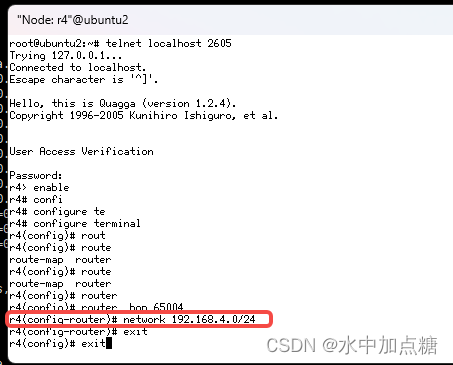
之后再ping就可以通了
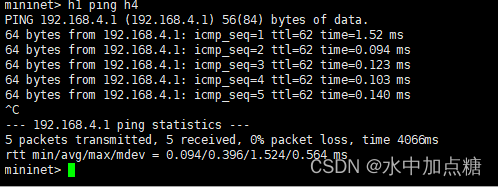
最终的路由记录与intent信息如下:

最后再来个拓扑图回忆一下:

参考资料
- https://wiki.onosproject.org/display/ONOS/Basic+ONOS+Tutorial#BasicONOSTutorial-Introduction
- https://wiki.onosproject.org/display/ONOS/SDN-IP+Architecture
- quagga+mininet ospf
- https://medium.com/@sreejithkj52/onos-tutorial-with-mininet-part-2-ed1b30582da0
- https://wiki.onosproject.org/display/ONOS/SDN-IP+Reactive+Routing
- https://wiki.onosproject.org/display/ONOS/vRouter
- https://github.com/ralvarep/ONOS-SDN-IP/blob/master/scenario_1/README.md
- https://wiki.onosproject.org/display/ONOS/Intent+Framework
- https://wiki.onosproject.org/display/ONOS/SDN-IP+Deployment+Guidelines


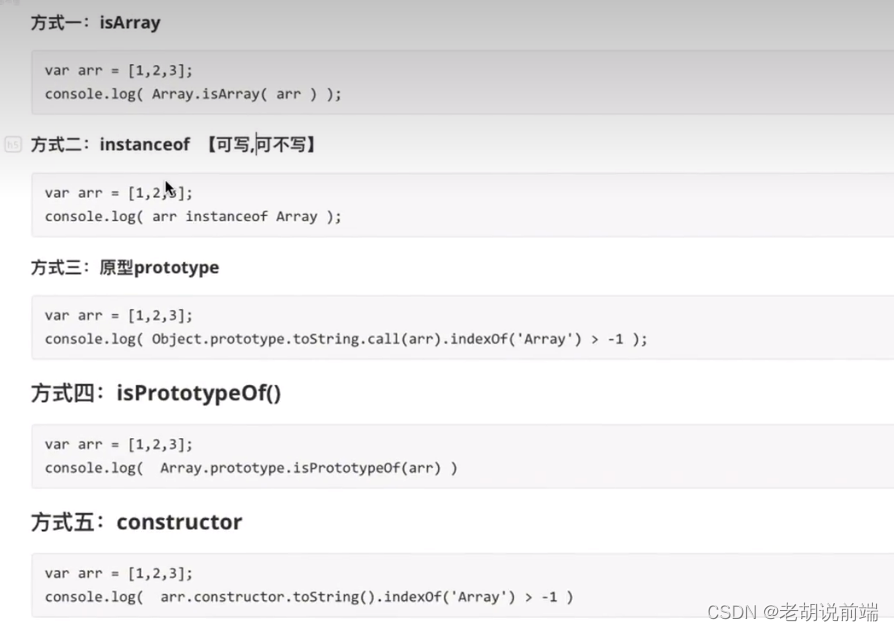
![LeetCode 刷题 [C++] 第236题.二叉树的最近公共祖先](https://img-blog.csdnimg.cn/direct/17587ee6080a41c1843524b11bebff7b.png)









